
Self-regulating
and power limiting
heating cable systems
Installation and maintenance manual

2 | nVent.com/RAYCHEM

nVent.com/RAYCHEM
|
3
1
General information 4
2
Heating cable selection 9
3
Heating cable installation 10
4
Components installation 19
5
Thermostats 25
6
Thermal insulation and marking 26
7
Power supply and electrical protection 28
8
Heating cable testing 28
9
Operation, maintenance and
pipe repairs
31
10
Heating cable damage 32
11
Troubleshooting guide 32
Register for your extended warranty
on nVent.com/RAYCHEM.

4 | nVent.com/RAYCHEM
1 GENERAL INFORMATION
Use of the manual
The Installation and Maintenance manual is for nVent
RAYCHEM self-regulating and power limiting heating cable
systems on thermally insulated pipes and vessels only.
For information regarding other applications contact your
nVentrepresentative.
BSA, BTV, QTVR, XTV, KTV, HTV Self Regulating Heating Cables
L
N
• Power output varies with temperature.
As pipe temperature increases, power output decreases.
• At high temperatures, the polymer expands, reducing the
number of the conductive paths, and thus reducing current
flow.
• At low temperatures, there are many conductive paths,
allowing current to flow between the conductors.
VPL Power Limiting Heating Cables
L
N
Important
For the nVent warranty to apply, the instructions that are
included in this manual and product packages must be
followed. The installation must be compatible with local
requirements applicable to electric heat- tracing systems.

nVent.com/RAYCHEM
|
5
Specic Conditions of Use
The following limiting temperatures for the end seals, splices and power
connections shall not be exceeded:
+110°C for the S-20 and E-20
+260°C for the E-40 and S-40
+150°C for the C-150-E, S-150 and E-150
+151°C for the E-100, E-100-L and JBS-100
+155°C for the JBM-100 and T-100
+110°C for the C25-21 and C25-100
+180°C for the C25-100-METAL/C3/4-100-METAL
The E-100, E-100-L, JBM-100, JBM-100-L, JBS-100, JBS-100-L and
T-100 have limiting temperatures based on an internal component in
these accessories. When located on a pipe or other work piece surface,
a maximum pipe temperature of 250°C will not cause the limiting
temperatures of 151°C or 155°C to be exceeded
The end seals, splices and power connections have the following
associated ambient temperatures:
–60°C to +56°C for the E-20 and S-20
–60°C to +56°C for the E-40 and S-40
–55°C to +56°C for the T-100, JBM-100, JBS-100, JBU-100 and E-100
–40°C to +56°C for the JBS-100-L, JBM-100-L, and JBU-100-L
–55°C to +55°C for the C-150-E, S-150 and E-150
–40°C to +40°C for the E-100-L
–55°C to +110°C for the C25-21 and C25-100
–60°C to +180°C for the C25-100-METAL / C3/4-100-METAL /
C25-100-METAL-NP / C3/4-100-METAL-NP / C25-100-METAL-SS
• The assembly of glands, splices and end terminations
shall be carried out in accordance with the manufacturing
instructions.
• The heating element supply circuit must include an electrical
protection device in conformity with Clause 4.4 of IEC
60079-30-1. For the JBM-100-L, JBU-100-L and JBS-100-L
this shall be limited to 20A maximum when used at ambient
temperatures above 40°C.
• The minimum installation temperature of the heating
cables is –60°C. The minimum bending radii at specific
temperatures are shown on the next pages of this document.
• The supply to the heating unit must be terminated in a
suitably certified terminal enclosure.
• At ambient temperatures above 40°C temperature resistant
power cable suitable for temperatures above 90°C and metal
glands must be used.
• The minimum installation temperature for E-20 and S-20 is
–20°C.

6 | nVent.com/RAYCHEM
• The installer is to carry out a dielectric strength test on
Ex equipment in which the C25-21, C25-100 and C25-100-
Metal / C3/4-100-Metal / C25-100-Metal-NP / C3/4-100-
Metal-NP / C25-100-Metal-SS connection kit is fitted. No
dielectric breakdown shall occur. (Alternatively, an insulation
resistance test may be undertaken in accordance with IEC
60079-30-2)
ATEX
Certicate No Code
BTV SGS20ATEX0048X
II 2 G Ex 60079-30-1 eb IIC T6 Gb
II 2 D Ex 60079-30-1 tb IIIC T80°C Db
or
II 2 G Ex 60079-30-1 eb mb IIC T6 Gb
II 2 D Ex 60079-30-1 mb tb IIIC T80°C Db
Tmin –60°C
QTVR SGS20ATEX0050X
II 2 G Ex 60079-30-1 eb IIC T4 Gb
II 2 D Ex 60079-30-1 tb IIIC T130°C Db
or
II 2 G Ex 60079-30-1 eb mb IIC T4 Gb
II 2 D Ex 60079-30-1 mb tb IIIC T130°C Db
Tmin –60°C
XTV SGS20ATEX0049X
II 2 G Ex 60079-30-1 eb IIC T* Gb
II 2 D Ex 60079-30-1 tb IIIC T**°C Db
or
II 2 G Ex 60079-30-1 eb mb IIC T* Gb
II 2 D Ex 60079-30-1 mb tb IIIC T**°C Db
Tmin –60°C (* ** see schedule)
KTV SGS20ATEX0051X
II 2 G Ex 60079-30-1 eb IIC T226°C(T2) Gb
II 2 D Ex 60079-30-1 tb IIIC T226°C Db
or
II 2 G Ex 60079-30-1 eb mb IIC T226°C(T2)
Gb
II 2 D Ex 60079-30-1 mb tb IIIC T226°C Db
Tmin –60°C (* ** see schedule)
HTV PTB21ATEX1003X
II 2 G Ex 60079-30-1 eb IIC T* Gb
II 2 D Ex 60079-30-1 tb IIIC T**°C Db
or
II 2 G Ex 60079-30-1 eb mb IIC T* Gb
II 2 D Ex 60079-30-1 mb tb IIIC T**°C Db
Tmin –60°C (* ** see schedule)
VPL SGS20ATEX0045X
II 2 G Ex 60079-30-1 eb IIC T* Gb
II 2 D Ex 60079-30-1 tb IIIC T**°C Db
or
II 2 G Ex 60079-30-1 eb mb IIC T* Gb
II 2 D Ex 60079-30-1 mb tb IIIC T**°C Db
Tmin –60°C (* ** see schedule)
IECEx
Certicate No Code
BTV IECEx BAS
20.0011X
Ex 60079-30-1 eb IIC T6 Gb
Ex 60079-30-1 tb IIIC T80°C Db
or
Ex 60079-30-1 eb mb IIC T6 Gb
Ex 60079-30-1 mb tb IIIC T80°C Db
Tmin –60°C

nVent.com/RAYCHEM
|
7
QTVR IECEx BAS
20.0013X
Ex 60079-30-1 eb IIC T4 Gb
Ex 60079-30-1 tb IIIC T130°C Db
or
Ex 60079-30-1 eb mb IIC T4 Gb
Ex 60079-30-1 mb tb IIIC T130°C Db
Tmin –60°C
XTV IECEx BAS
20.0012X
Ex 60079-30-1 eb IIC T* Gb
Ex 60079-30-1 tb IIIC T**°C Db
or
Ex 60079-30-1 eb mb IIC T* Gb
Ex 60079-30-1 mb tb IIIC T**°C Db
Tmin –60°C (* ** see schedule)
KTV IECEx BAS
20.0014X
Ex 60079-30-1 eb IIC T226°C(T2) Gb
Ex 60079-30-1 tb IIIC T226°C Db
or
Ex 60079-30-1 eb mb IIC T226°C(T2) Gb
Ex 60079-30-1 mb tb IIIC T226°C Db
Tmin –60°C (* ** see schedule)
HTV IECxPTB21.0007X Ex 60079-30-1 eb IIC T* Gb
Ex 60079-30-1 tb IIIC T**°C Db
or
Ex 60079-30-1 eb mb IIC T* Gb
Ex 60079-30-1 mb tb IIIC T**°C Db
Tmin -60°C (* ** see schedule)
VPL IECEx BAS
20.0008X
“Ex 60079-30-1 eb IIC T* Gb
Ex 60079-30-1 tb IIIC T**°C Db
or
Ex 60079-30-1 eb mb IIC T* Gb
Ex 60079-30-1 mb tb IIIC T**°C Db
Tmin –60°C (* ** see schedule)”
Certicate No Code
Product
name
in sap New Certicate Ex Marking
BTV
CABLE
ТС RU C-BE.
МЮ62.В.00054/18
1Ex e IIC T6 Gb X 1Ex e mb II C T6 Gb X
Ex tb IIIC T80°C Db X Ex tb mb IIIC T80°C
Db X
Ta –60°C…+56°C IP66
QTVR
CABLE
ТС RU C-BE.
МЮ62.В.00054/18
1Ex e IIC T4 Gb X 1Ex e mb IIC T4 Gb X
Ex tb IIIC T130°C Db X Ex tb mb IIIC T130°C
Db X
Ta –60°C…+56°C IP66
XTV
CABLE
ТС RU C-BE.
МЮ62.В.00054/182
1Ex e IIC T* Gb X 1Ex e mb IIC T* Gb X
Ex tb IIIC T* Db X Ex tb mb IIIC T* Db X
Ta –60°C…+56°C IP66
KTV
CABLE
ТС RU C-BE.
МЮ62.В.00054/18
1Ex e IIC 226°C (T2) Gb X 1Ex e mb IIC 226°C
(T2) Gb X
Ex tb IIIC T226°C Db X Ex tb mb IIIC T226°C
Db X
Ta –60°C…+56°C IP66
HTV
CABLE
Approval pending
VPL
CABLE
ТС RU C-BE.
МЮ62.В.00054/18
1Ex e IIC T* Gb X 1Ex e mb IIC T* Gb X
Ex tb IIIC T* Db X Ex tb mb IIIC T* Db X
Ta –60°C…+56°C IP66
BSA cables are EAC certied to TR CU 004/2011

8 | nVent.com/RAYCHEM
Rated Voltage
BTV1, QTVR1, KTV1, XTV1, HTV1, VPL1: 110V, 120V
BTV2, QTVR2, KTV2, XTV2, HTV2, VPL2: 230V, 277V, VPL4: 400V, 480V
BSA BTV QTVR XTV KTV HTV VPL
Min. Bending
Radius (mm)
–60°C ≤ T <
–20°C
35 35 35 51 26 25 19
–20°C ≤ T <
–10°C
30 30 30 35 20 20 15
–10°C ≤ T < 0°C 25 25 25 25 15 15 15
0°C ≤ T < +10°C 20 20 20 20 15 15 15
T ≥ +10°C 10 12 12 12 12 13 12
Minimum
Installation
Temperature
–60°C –60°C –60°C –60°C –60°C –60°C –60°C
BSA BTV QTVR XTV KTV HTV VPL
Max. continuous
operating Temp
(energized)
65°C 65°C 110°C 121°C 150°C 205°C
See
table
below
Max. intermittent
exposure Temp
(1000h
cumulative,
energized/
de-energized)
85°C 85°C 110°C 250°C 250°C **260°C –
Max. continuous
exposure Temp
(de-energized)
65°C 65°C 110°C 160°C 160°C 205°C 260°C
Self-limiting
Temperature in
accordance with
IEC/EN
60079-30-1
T6 T4
T3
(T2:
20XTV2,
15/
20XTV1)
T2
T3
(T2:
20HTV)
T*
Power Limiting
Temperature
(*By design)
- - - - - T*
** 2000 hours for HTV, for durations applicable to other exposure temperatures
between 205°C and 260°C, contact nVent.
Maximum continuous operating temperature table
(heating cable energized)
Cable 110 V 230 V 254 V 277 V 400 V 480 V
5VPL1-CT 235°C - - - - -
10VPL1-CT 215°C - - - - -
15VPL1-CT 190°C - - - - -
20VPL1-CT 150°C - - - - -
5VPL2-CT - 230°C 225°C 225°C - -

nVent.com/RAYCHEM
|
9
Cable 110 V 230 V 254 V 277 V 400 V 480 V
10VPL2-CT - 210°C 200°C 195°C - -
15VPL2-CT - 180°C 145°C 105°C - -
20VPL2-CT - 150°C - - - -
5VPL4-CT - - - - 230°C 230°C
10VPL4-CT - - - - 215°C 205°C
15VPL4-CT - - - - 195°C 160°C
20VPL4-CT - - - - 150°C 150°C
Warning
As with any electrical equipment or wiring installation operating
at line voltages, heating cable and component damage or
incorrect installation that allows the penetration of moisture
or contamination can lead to electrical tracking, arcing and
potential fire hazard.
Do not connect heating cable conductors together or this will
result in a short circuit.
Any unconnected heating cable end must be sealed with a
nVent approved end seal.
To prevent fire or explosion in hazardous areas, verify that the
maximum sheath temperature of the heating cable is below the
auto-ignition temperature of the gases in the area. For further
information, see design documentation.
The purchaser should make the manufacturer aware of any
external effects or aggressive substances that the equipment
may be exposed to.
2 HEATING CABLE SELECTION
The design of electrical resistance heat tracing systems
shall be overseen by persons knowledgeable of heat tracing
following the design methodology for explosive atmospheres as
specified by the manufacturer.
Check the design specification to make sure the proper
heating cable is installed on each pipe or vessel. Refer to nVent
product literature and the TraceCalc software to select the
proper heating cable for each thermal, chemical, electrical and
mechanical environment.
Heat tracing system design documentation
The heat tracing system documentation shall be retained for
each heat tracing circuit for as long as the system is in use.

10 | nVent.com/RAYCHEM
3 HEATING CABLE INSTALLATION
Persons involved in the installation and testing of electric
heat tracing systems shall be suitably trained in all special
techniques required. Installation shall be carried out under the
supervision of a qualified person
De-energise all power circuits before installation or servicing
The insulation resistance of the heating cable shall be
measured and recorded after installation and shall not be less
than 20 Megaohms
3.1 Heating cable storage
• Keep ends of heating cable and kit components dry before
and during installation
• Temperature range: –40°C to +60°C
• Protect the heating cable from mechanical damage
3.2 Pre-installation checks
Check materials received:
• Review the heating cable design and compare the list of
materials to the catalogue numbers of heating cables and
electrical components received to confirm that proper
materials are on site. The heating cable type is printed on its
outer jacket.
• Temperature exposure must not exceed that specified in
nVent product literature. Exceeding these limits will impair
product performance. Check that expected exposure is
within these limits.
• Ensure that the heating cable voltage rating is suitable for
the service voltage available.
• Do not energize cable when it is coiled or on the reel.
• Inspect heating cable and components for in-transit
damage. An insulation resistance test (see section 8) on
each reel is recommended.
Check piping to be traced:
• Ensure all pressure testing is complete and pipework has
final paint coating.
• Walk the system and plan the routing of the heating cable on
the pipe.
• Check pipework against specification drawing. If different
consult design authority.
• Inspect piping for burrs, rough surfaces, sharp edges etc.
which could damage the heating cable. Smooth off or cover
with layers of glass cloth tape or aluminium foil.

nVent.com/RAYCHEM
|
11
3.3 Heating cable handling
Heating cable handling tips:
• Paint and pipe coatings must be dry to the touch before
heating cable installation.
• When pulling the heating cable, avoid:
– sharp edges
– excessive pulling force
– kinking and crushing
– walking on it, or running over it with equipment
Heating cable pulling tips:
• Use a reel holder that pays out smoothly with little tension.
• Keep heating cable strung loosely but close to the pipe
being traced to avoid interference with supports and
equipment.
• Pay out designed length and mark (i.e. with fixing tape) on
cable while still on reel.
• Leave the appropriate amount of heating cable at all power
connection, splice, tee and end seal locations.
(Refer to component installation instructions)
– Add additional heating cable to trace the fittings and
supports or for spiralling as required by the design
specifications, or consult nVent product literature for design.
• Protect all heating cable ends from moisture, contamination
and mechanical damage or other interference if left exposed
before component installation.
3.4 Heating cable attachment recommendations
• The heating cable may be installed straight, spiralled or in
multiple runs as required by the design specification, nVent
product literature or TraceCalc software.
– Do not use metal attachments, vinyl electrical tape or duct
tape as heating cable damage may result.
– Self-Regulating technology allows for the multiple
overlapping of the heating cable on to itself.
• Power Limiting technology dictates that the heating cable
can be overlapped only once on to itself. If VPL cables are
installed parallel to each other, please allow for minimum 15
mm clearance.

12 | nVent.com/RAYCHEM
For VPL heating cable only:
• Fix in place with a minimum of two wraps the appropriate
self-adhesive glass cloth tape (see figure 1) or plastic cable
ties at 300 mm intervals and additionally where necessary.
• Plastic cable ties must have a temperature rating that
matches the system exposure temperature.
• The heating cable’s minimum bend radius must not be
exceeded (refer to p. 6)
Bend the cable only in upright position
• The heating cable does not bend easily in the flat plane.
Do not force such a bend, as the heating cable may be
damaged.
3.4.1 Straight tracing
• Straight trace the pipe unless the design calls for spiralling
(see 3.4.2).
• On horizontal pipes fix on lower quadrant as shown in Figure
1 and not on bottom of pipe.
• To prevent overheating, be sure the location of the power
limiting heating cable is planned so that the active heating
zone will not extend into the component. Read the kit
installation instructions and plan the component location
before permanently attaching the cable to the pipe. Ensure
that the active heating zones are located where heat is
required i.e. on the pipe.
• Thermally insulate and weatherproof to specification.

nVent.com/RAYCHEM
|
13
Figure 1
Glass cloth tape
(typical)
Tight on pipe
Top
Pipe
Thermal
insulation
(typical)
45°
(nominal)
300 mm
nVent attachment tapes:
GT66 Self-adhesive glass cloth tape
General purpose tape. Not for stainless-steel surfaces
or for installation temperatures <4°C.
GS54 Self-adhesive glass cloth tape
Recommended for use on stainless-steel and cupro-
nickel surfaces or for installation temperatures <4°C.
Figure 2
ATE-180 Aluminium tape
Use only if the design requires it.
ATE-180 improves the heat transfer and increases the power
output of the heating cable.
Attach the heating cable to the pipe as shown in Figure 2.

14 | nVent.com/RAYCHEM
3.4.2. Spiral tracing
• Alternative spiralling methods are shown in
Figures 2a and 2b.
• Only spiral heating cable on pipe when called for by design.
• To prevent overheating, be sure the location of the power
limiting heating cable is planned so that the active heating
zone will not extend into the component. Read the kit
installation instructions and plan the component location
before permanently attaching the cable to the pipe. Ensure
that the active heating zones are located where heat is
required i.e. on the pipe.
Spiral Pitch Table (mm).
NB NPS Spiral Ratio
(mm) (inches) Metres of cable per metre of pipe
1.1 1.2 1.3 1.4 1.5
25 1 250 170 140 110 100
32 1
1/4
310 210 170 140 130
40 1
1/2
350 240 190 160 140
50 2 430 300 240 200 180
65 2
1/2
520 360 290 240 210
80 3 630 430 350 290 260
90 3
1/2
720 490 390 330 290
100 4 800 560 440 370 330
125 5 990 680 550 460 400
150 6 1180 810 650 550 480
200 8 1520 1050 840 710 620
Example:
For pipe of 80 mm NB (3" NPS) requiring 1.3 metres of heating
cable per metre of pipe, pitch is 350 mm.

nVent.com/RAYCHEM
|
15
Figure 2a
Glass cloth tape
(typical)
Heating
cable
Pipe length
Pipe
Apply glass
cloth tape
before spiralling
cable on pipe
Heating cable length
Wrap loops in
opposite
direction
Tape after
spiralling cable
on pipe
Pitch
Heating cable length = pipe length x spiral ratio
Refer to design specication for spiral ratio
Step 1 Make starting loop as shown
Step 2 Grasp loop and wind around pipe
Step 3 Space evenly and attach to pipe.
Thermally insulate and weatherproof to specification
Figure 2b
Pipe
Heating cable
Glass cloth tape
(typical)
Pitch
Refer to design specification for spiral pitch
Mark the pipe at the spiral pitch or use a simple length gauge
Fix the heating cable as installation progresses
Thermally insulate and weatherproof to specification
3.5 Cutting the heating cable
• Cut the heating cable to length after it is attached to the
pipe. Before cutting it, confirm the tracing allowance as per
Sections 3.3 and 3.6.
• nVent RAYCHEM heating cable can be cut to length without
affecting the heat output per metre.
3.6 Typical installation details
• Typical installation details for fixing heating cable to pipe
fittings are shown hereafter.
General notes:
• Trace pipe fittings as shown to allow easy maintenance.
• Consult the design specification or nVent product literature
or TraceCalc software for the tracing requirements for
fittings and supports.

16 | nVent.com/RAYCHEM
3.6.1 Valve
Figure 3
The heating cable conguration will
vary for different valve shapes and
heating cable lengths.
Heating cable
Glass tape
Valve body
Pipe
• Refer to design specification for additional heating cable
length.
• Fix with self-adhesive glass cloth tape.
• Thermally insulate and weatherproof to specification
(including valve stem).
3.6.2 Elbow
Figure 4
Thermal insulation
Pipe
Glass cloth tape
(typical)
Heating cable
• Fix heating cable to outside (long) radius of elbow
• Fix with self-adhesive glass cloth tape
• Thermally insulate and weatherproof to specification
• Follow the recommendations for cutting and stripping
heating cables; they are included in the component
installation instructions.

nVent.com/RAYCHEM
|
17
3.6.3 Flange
Figure 5
Heating cable
Pipe Glass cloth tape (typical)
• Additional heating cable is 2-3 times diameter of pipe
(typical)
• Fix with self-adhesive glass cloth pipe
• Thermally insulate and weatherproof to specification
3.6.4 Pipe bar hanger
Figure 6
Glass cloth tape
(typical)
Bar hanger
Weatherproong
Thermal insulation
Pipe
Heating cable
Bar hanger
Sealer
Sealer
Heating cable

18 | nVent.com/RAYCHEM
– Do not clamp heating cable with support. Heating cable
must be over the support
• No additional heating cable is required for bar or rod pipe
hangers unless called for in the design specification, then
use loop length specified
• Fix with self-adhesive glass cloth tape
Thermally insulate and weatherproof to specification
3.6.5 Pipe support shoe
Figure 7
Side view
Heating cable Pipe
Support shoeGlass cloth tape
(typical)
Pipe
• Refer to design specification for additional heating
cable length
• Fix with self-adhesive glass cloth tape
• Thermally insulate and weatherproof to specification
Bottom view

nVent.com/RAYCHEM
|
19
4 COMPONENTS INSTALLATION
General notes:
Select the required components from nVent product literature or
use the TraceCalc software.
nVent RAYCHEM component kits (including power connections,
splices and end seals) must be used to satisfy Standards and
Approval Body requirements.
Installation instructions included in the kit must be followed,
including those for preparation of the heating cable conductors
for connections. Before assembly, use the guide given in the
instructions to ensure that the kit is correct for the heating
cable and environment.
– nVent RAYCHEM self-regulating and power limiting
heating cables are parallel circuit design. Do not twist the
conductors together as this will result in a short circuit.
4.1 Components required
• For the installation of all components refer to the relevant
component installation instructions.
• Required for each heating cable run:
Power connection and insulation entry kit
End seal.
• As required:
Splice. Tee-splice. Junction box. Three connection kits and
three insulation entry kits. Accessories (pipe straps, fixing
tape, support brackets, labels, etc.).

20 | nVent.com/RAYCHEM
Valve
End seal
Heating cable
JBU-100
SB-100
4.2 Typical systems installation
Below components are not suitable for BSA. You can find the
solutions for BSA in DOC2210 or contact your local nVent
representative.
Figure 8a
Page is loading ...
Page is loading ...
Page is loading ...
Page is loading ...
Page is loading ...
Page is loading ...
Page is loading ...
Page is loading ...
Page is loading ...
Page is loading ...
Page is loading ...
Page is loading ...
Page is loading ...
Page is loading ...
Page is loading ...
Page is loading ...
Page is loading ...
Page is loading ...
Page is loading ...
Page is loading ...
-
 1
1
-
 2
2
-
 3
3
-
 4
4
-
 5
5
-
 6
6
-
 7
7
-
 8
8
-
 9
9
-
 10
10
-
 11
11
-
 12
12
-
 13
13
-
 14
14
-
 15
15
-
 16
16
-
 17
17
-
 18
18
-
 19
19
-
 20
20
-
 21
21
-
 22
22
-
 23
23
-
 24
24
-
 25
25
-
 26
26
-
 27
27
-
 28
28
-
 29
29
-
 30
30
-
 31
31
-
 32
32
-
 33
33
-
 34
34
-
 35
35
-
 36
36
-
 37
37
-
 38
38
-
 39
39
-
 40
40
Raychem Selbstreg. Kabel Installation guide
- Type
- Installation guide
- This manual is also suitable for
Ask a question and I''ll find the answer in the document
Finding information in a document is now easier with AI
Related papers
-
Raychem Self-Reg Cable Installation guide
-
Raychem S-40 Installation guide
-
Raychem Series Resistance Heating Cable Installation guide
-
Raychem IEK2x-CON Installation guide
-
Raychem NGC-20 Hardware Manager Installation guide
-
Raychem NGC-20 Hardware Manager (Field Tech) Installation guide
-
Raychem Elexant 450c Installation guide
-
Raychem Leak Detection Installation guide
-
Raychem In-Pipe Retro - 120 B Installation guide
-
Raychem Miser WinterGard Installation guide
Other documents
-
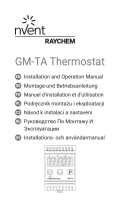 nvent GM-TA Thermostat User manual
nvent GM-TA Thermostat User manual
-
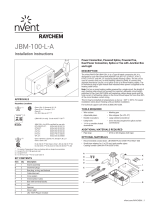 nVent RAYCHEM JBM-100-L-A Multi Entry Connection Kit User manual
nVent RAYCHEM JBM-100-L-A Multi Entry Connection Kit User manual
-
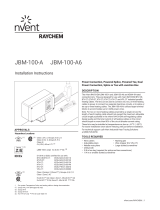 nVent RAYCHEM JBM-100-A Multiple-Entry Power-Tee Connection User manual
nVent RAYCHEM JBM-100-A Multiple-Entry Power-Tee Connection User manual
-
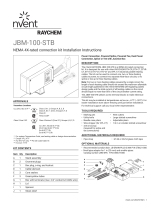 nVent RAYCHEM JBM-100-STB NEMA 4X-Rated Connection Kit User manual
nVent RAYCHEM JBM-100-STB NEMA 4X-Rated Connection Kit User manual
-
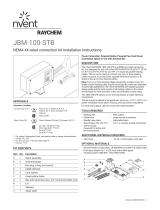 nVent RAYCHEM JBM-100-STB NEMA 4X-Rated Connection Kit User manual
nVent RAYCHEM JBM-100-STB NEMA 4X-Rated Connection Kit User manual
-
nVent RAYCHEM H59057 Single Entry Power Connection User manual
-
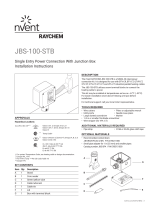 nVent RAYCHEM JBS-100-STB Single Entry Power Connection User manual
nVent RAYCHEM JBS-100-STB Single Entry Power Connection User manual
-
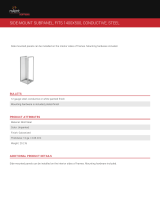 nVent Hoffman Side-Mount Subpanel Fits 1400×500 Conductive Steel Operating instructions
nVent Hoffman Side-Mount Subpanel Fits 1400×500 Conductive Steel Operating instructions
-
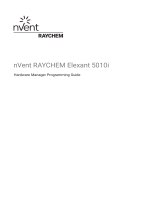 nvent NGC-20 User manual
nvent NGC-20 User manual
-
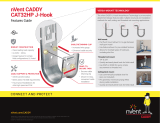 nvent CADDY CAT32HP Operating instructions
nvent CADDY CAT32HP Operating instructions
















































